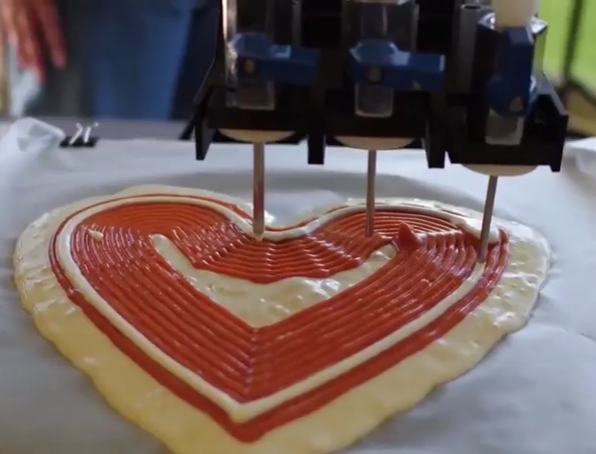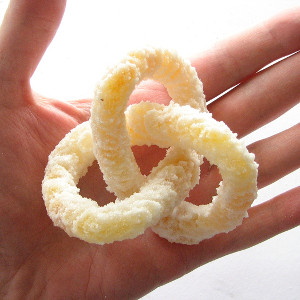Most of us will be familiar with the concept behind the Star Trek food synthesizer – a device using modified transporter technology to create custom meals from stored patterns using basic, elemental materials. Now, scientists say they’ve moved a step closer to that goal using 3D printing…
 A 3D printer set up to make pizzas in any shape you want, from a variety of ingredients.
A 3D printer set up to make pizzas in any shape you want, from a variety of ingredients.
But the ingredients are real food, not microlysed fundamental
substances. More for fun than utility.
Dr. Jin-Kyu Rhee, Associate Professor at Ewha Women’s University in South Korea, and her team have created a system that uses 3D printing technology to synthesize various food products from basic ingredients.
The system uses ‘microlysed’ materials including proteins and other ingredients to print layers that accumulate into ‘blocks’ of food products with the texture, flavour and other sensory characteristics diners desire, while incorporating the nutritional characteristics users choose.
Early days…
It’s still early days for the research. Only boring-looking square blocks of food materials have been produced so far. There’s no word on what they look or taste like, but Jin-KJyu says custom mouth feel mimicking real-world foods can be duplicated, along with flavours and textures:
“We think that, one day, people could have cartridges that contain powdered versions of various ingredients that would be put together using 3-D printing and cooked according to the user’s needs or preferences.”
I see no problem with the prediction. But I wonder how appetizing and satisfying such ‘foods’ would be?
We are picky eaters…
I think those of us in the developed world, who are used to a world of plenty and almost infinite variety at the supermarket would require some coaxing, to switch to ‘synthesized’ food. But Jin-Kyu says there’s a definite need for her technology in a future where the world struggles to feed billions more people than it must today.
Among the benefits she sees associated with ‘printed’ foods: Longer safe storage times and dramatically-reduced food waste. The system could, theoretically be used either commercially, on a large scale, to produce standardized foods, or at home on a small-appliance scale to create truly customized foods. The home alternative could also dramatically reduced the amount of storage space and transportation infrastructure required along the food supply chain.
My take…
One aspect of her plan that Jin-Kyu doesn’t go into is the cost. The technology might advance in sophistication at an astounding rate – as many good tech ideas do, these days – but her goals of feeding the multitudes won’t be realized until she and her colleagues come up with a way bring down the cot to something the Third World can afford.
I might try 3D ‘printed’ food as a novelty. but you’d have to do something pretty dramatic, like print me up a Steak, to convert me from good, old naturally grown foods. I may be old-fashioned, but I just don’t trust these newfangled gadgets – especially in their early stages of evolution.
~ Maggie J.

